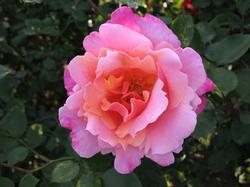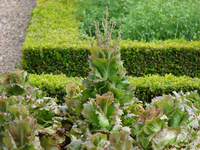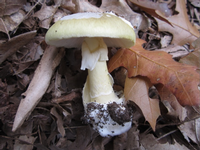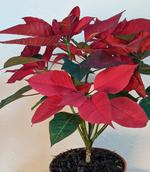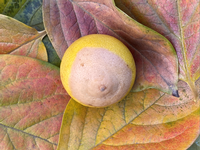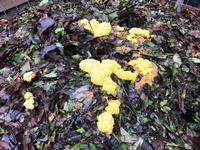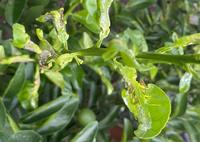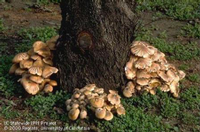December Tips
Monthly tips are categorized by To-Dos, What to Plant, or Pests and Diseases. Scroll through the list to see items in each category. Also, refer to our list of tips useful for any month.
Jump to (links don't work in Firefox):
1. To-do
-
Clean Garden Beds
-
In preparation for winter, remove dead plants, leaves, fruit (mummies), and flowers from garden beds. Many insects and diseases overwinter in fallen debris. Do not compost any plant materials you think might be diseased.
- December -
Holiday Ideas
- Prune your evergreen trees and shrubs now and use the cuttings for holiday wreaths.
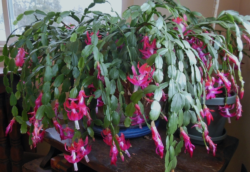
Christmas cactus, poinsettias, cyclamen, kalanchoe, amaryllis and more help make the house look festive at this time of year. They prefer cool temperatures, so find a place for them away from a heating vent. To avoid over watering, check the soil and give them water only when dry.
Consider a living Christmas tree that can later be planted in your garden. A smaller tree doesn’t have room for as many ornaments, but is more likely to adapt well when planted outdoors. You can even rent a tree from Our City Forest as it's on its way to a permanent home in the community.
You can bring some of the beauty of your garden inside to decorate your home for the holidays. Consider some of these seasonal items for tree ornaments, mantle decorations, garlands, and wreaths: laurel leaves, lemons, pine cones, nuts, pyracantha berries, eucalyptus pods, grape vines, rosemary, and rose hips.
- December -
Prune Blackberries
-
Little or no pruning is required during the first year after planting. Blackberries should be pruned as soon as the harvest is completed. All wood that has produced the current crop should be removed. The canes should be trellised immediately after pruning. Put up only the larger canes and prune the small ones. Generally, no more than 9 canes should be put up on the trellis. A fan-like arrangement is the best way to trellis the vines. Tipping (removing the end of the canes) forces out the laterals on which fruits will be borne the following season. Consult our Berries page for more information.
- December -
Dormant Rose Pruning
- Winter is the best time to prune roses even if they haven’t gone completely dormant. The old advice was to cut the canes down drastically, but that isn’t necessary for our climate. Instead, just cut back about one-third to one-half of the total height. In other words, take a 4-foot bush down to about 2–3 feet. When cutting back a cane, make the cut at an angle just above an outward pointing bud. Take out any dead or diseased canes, remove suckers below the graft union, and branches that are crossing or growing towards the middle of the plant to improve airflow. Clean up old leaves on the plant and ground to reduce rust and black spot.
More Information: Rose Care
- January, February, December -
Poisonous Plants List
-
As we approach the holidays, there are a lot of questions on poisonous plants. Fortunately, many of these plants have a very bitter taste that limits the amount of the plant eaten.
Poinsettia and mistletoe should be kept away from curious children, but the list includes other flowers and plants such as azaleas, calla lily, carnation, daffodil, foxglove, hydrangeas, iris, lantana, narcissus, poppy, sweet pea and tulips.
Different parts of the plant may be toxic. Consult the UC Poison Plant web page for detailed information.
- November, December -
Wet Soil
-
The clay soils which dominate our area are particularly susceptible to compaction, especially when they have received a lot of rain. These soils are characterized by small mineral particles. Hence squeezing out the air spaces makes it more difficult for plant roots and soil organisms to get the oxygen they need to flourish. Try to avoid walking on or using heavy equipment on soil that is wet. Digging in wet soil can also destroy the structure, breaking up useful soil aggregates and earthworm tunnels. Try to wait until the soil is moist, not wet or dry, for easiest tillage. If you must walk or stand on the soil, use a board to distribute your weight over a broader area. Mulch can also create a bit of a cushion and help minimize compaction.
- February, March, December -
Winter Irrigation
-
Depending on the fall weather and rain frequency, you will likely set your sprinklers to water less frequently or even turn them off for a while. It's still important to check outdoor plants to ensure they have enough water. While they need less water when it's cool, it's important to make sure they don't dry out. If you have a lawn and rains haven't come, irrigate the lawn once or twice this month.
If it has been raining, the soil may be saturated, so be careful if you have to walk on it to not compact it. Also, if the soil is waterlogged, vital space for air needed for plants and worms, and excess water can drown beneficial soil organisms and contribute to rotting roots.
- January, February, December -
Houseplants Repotting
- If you’ve noticed the soil in your houseplants is drying out quickly, or leaves are turning yellow, check whether the plant is rootbound. The most obvious clue is roots growing from a drainage hole or on top of the soil. Especially vigorous roots can break pots! UC scientists recommend choosing a new container no more than 2 inches larger in diameter, with drainage holes. Don’t add stones to the bottom – they hinder drainage, causing root rot. Use new potting soil, not garden soil that may harbor diseases or pests. Unwind and trim roots that circle the pot. Add soil to the container, keep the root ball an inch below the rim, and water well.
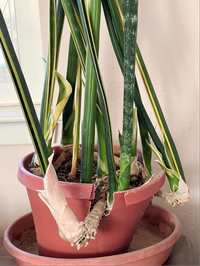
More information: Repotting Houseplants
- January, February, December, Any month -
Fruit Tree Pruning
- Winter is the best time to prune most deciduous fruit trees because the tree structure is easily seen once the leaves drop. Start by removing crossing branches, broken branches, and diseased wood. Clean out suckers, and light branches. Trim the branches that grow vertically. Then make cuts to produce the desired height and shape and to allow sunlight into the center of the tree. Not sure about the shape? UC has more information in Publication 8057, Fruit Trees: Training and Pruning Deciduous Trees. View a pruning video using the link below or refer to Fruit Tree Pruning.
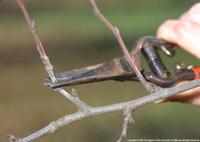 If you properly prune and care for fruit trees you will get the highest yield of fruit. A good rule of thumb is to prune plum, pluot, apple, and pear trees 15-20%; and peaches 50%.A reminder: since apricot and cherry trees are susceptible to Eutypa fungus, they should be pruned in late summer to allow pruning cuts to harden before winter rain.More information: Winter Fruit Tree Pruning Talk- January, February, December
If you properly prune and care for fruit trees you will get the highest yield of fruit. A good rule of thumb is to prune plum, pluot, apple, and pear trees 15-20%; and peaches 50%.A reminder: since apricot and cherry trees are susceptible to Eutypa fungus, they should be pruned in late summer to allow pruning cuts to harden before winter rain.More information: Winter Fruit Tree Pruning Talk- January, February, December -
Pruning Tools Maintenance
- Remember to keep your pruners and loppers clean and sharp. Read our tool care tips webpage for advice about cleaning, sharpening, and sterilizing your tools. - January, February, December, Any month
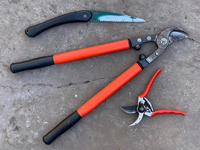
-
Frost Dates
-
The approximate first and last frost dates for Santa Clara County, depending on your location, are November 15 and March 15. These are important dates for gardeners to remember.
First frost date—this is the earliest date you should expect frost to occur. If you have plants that need to be brought in for the winter, or crops you need to pick before frost, this date will be important to you.
Last frost date—after this date, you wouldn't expect any more frosts. It's generally used as a milestone when pruning frost-sensitive plants (such as citrus where you don't want to stimulate delicate new growth until the danger of frost is past).
For our climate, the last frost date is not a reliable metric for when to transplant summer vegetables. Daytime temperatures and soil temperatures are more important. See entries for individual vegetables for specific recommendations.
Also see: Frost—Avoidance and Dealing with Damage
- January, February, March, November, December -
Fruit Tree Dormant Care
-
If you've had major pest infestations on your fruit trees this year, now is a good time to use dormant oil sprays. These are used to reduce overwintering populations of insects. They work by smothering soft-bodied insects and eggs when applied at the proper times in the life cycles of the pests. See our Fruit Tree and Vine Care Calendar for more information.
- December -
Prune Apple Trees
-
Once your apple tree loses its leaves, it's time to think about pruning. Apple trees produce fruit terminally on spurs located on wood 2 yrs. to 8 yrs. old. Weak and unproductive branches should be thinned out to allow the sunlight into the tree for good spur development. Older spurs can be rejuvenated by cutting back, especially following a light crop year. Tree height is maintained by cutting back upper branches to shorter laterals. Excessive pruning of a bearing tree can negatively affect its vigor and fruit. Consult our Fruit Tree Pruning page for more information.
- January, February, December -
Chill Hours
- Many fruit varieties require a certain amount of winter cold, measured in chill hours, in order to produce a good crop. Since we can’t change the weather, it’s important to select new fruit trees by considering their chill hour requirements. Here are UC suggestions for varieties of apple, pear, peach, nectarine, plums, and kiwifruit for planting in home gardens.UC has historical chill hours available for many locations in California, Gilroy is the only location located in Santa Clara County.- January, February, December
-
Paint Fruit Trees to Prevent Sunburn
-
After deciduous fruit trees have dropped their leaves, paint tree trunks with white latex paint diluted 1:1 with water to prevent sunburn. Preventing sunburn helps trees resist invasion by shot hole borers, which are tiny beetles that boreholes and lay eggs in the cambium layer of the tree. When the eggs hatch, young larvae feed and excavate tunnel galleries in the wood. For more information about identification and control see UC Pest Note on Shothole Borer.
- November, December -
Broccoli - Multiple Harvests
- Did you know that most broccoli plants can give you multiple harvests? The first central head that they produce will be the largest and fullest. But after you harvest that one, the plant will start to produce lots of smaller heads, called side shoots. They sprout from buds in the leaf axils, where the leaves join the stem of the plant. You can keep harvesting these tender shoots, sometimes called broccolini or baby broccoli, for another 2 to 3 months.
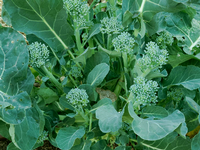
More Information: Growing Broccoli
- March, April, May, June, September, October, November, December -
Leafy Salad Plants
- Harvest your leafy vegetables early and often. Many leafy vegetables will bolt (go to flower) quickly if not harvested. When you harvest lettuce or similar greens, remove only the outer, older leaves. New leaves will continue to grow from the center, and you'll be able to eat salads all winter. Harvest head lettuce all at once when the head is full and firm. Watch for signs that plants are getting ready to bolt. That’s the signal it’s time to harvest the entire plant.
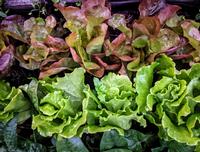 More Information: Growing lettuce in Santa Clara County- January, February, March, November, December
More Information: Growing lettuce in Santa Clara County- January, February, March, November, December -
Perennials and Bunch Grasses
- Winter is a good time to cut back perennials and bunch grasses. You can cut back some perennials all the way to the ground. These include yarrow, hummingbird sage, goldenrod, California aster, and most kinds of California fuchsia. You can divide other perennials at this time, such as Douglas iris, alum root, seaside daisy, woodland and beach strawberry, yarrow, yerba buena, daylilies, and chrysanthemums.You can propagate bunch grasses, sedges, and rushes by division this time of year. Examples of bunch grasses are purple needle grass (state grass of California), fescues, blue grama, leafy reed, oat, and deer grass. Some sedges are the meadow, clustered field, and San Diego sedge. Rushes include the common rush and the California gray rush.- January, February, December
-
Bolting Lettuces
- In garden terms, bolting means sending up a flower stalk, not desirable unless you plan to save seeds. Seed packets say lettuce matures in 60–80 days, but the timing also depends on the weather. In warm weather, lettuce matures and bolts much faster. In cool temperatures, seedlings grow more slowly but will still mature and bolt eventually. If the center of the lettuce starts to push upwards, that’s a clue that it’s starting to bolt. Another clue is if you tear a leaf and see milky sap instead of clear juices. Harvest as soon as you notice, before the leaves become unpleasantly bitter.
More information: Growing Lettuce
- January, February, March, November, December -
Fruit Tree Grafting
-
When pruning dormant fruit trees, you may want to save cuttings (scions) for later grafting onto other fruit trees. Grafting is a technique that allows you to have multiple varieties of compatible fruit on one tree and is a great space saver. It works by joining the vascular tissues of a shoot (scion) from one tree to a different tree that provides the root system. If the graft is successful, the scion will continue to grow and maintain the characteristics and fruit of the scion plant. Fruit trees can have new varieties grafted to them when they are dormant in January and February.
Scions are available in January or February at the California Rare Fruit Growers (CRFG scion exchange). Their January event also includes training classes. Check the CRFG - Santa Clara blog for the date.
More information on grafting can be found at:
- Grafting and Budding on the UC Home Orchard website
- Grafting Dormant Deciduous Fruit Scions at the California Rare Fruit Growers website
- Budding and Grafting Demystified presentation slides from the 2011 California Master Gardener Conference website
-
Certified Arborists
- Whether you prune your own trees or hire someone, it’s important that whoever does the job knows at least a little about tree anatomy, plant health, and the purpose of the plant (shade? privacy? fruit?). Knowing the difference between heading cuts and thinning cuts, how to locate a node to direct growth, and how to open up a tree for air circulation are all part of good tree pruning. An improper pruning job can stress the tree, spread disease, invite pests, and promote weak branching. These can lead to breakage, damage, and injury. The cheapest bid may end up costing more in the long run due to damage repair, lawsuits, and additional fix-it pruning. Take a class or read tree pruning guides if you want to do a good job yourself. If you hire someone, it is strongly recommended that you choose a certified arborist who has been specially trained and is insured. The International Society of Arboriculture can help you find a certified arborist in your area.More Information: Tree Pruning Guide- January, February, March, December
-
Stinkhorn Mushroom
- You might find stinkhorn mushrooms growing out of a lawn or a pile of mulch. They come in many colors, shapes, and sizes. They can grow as fast as four to six inches per hour. Stinkhorns get their name from their foul odor, described by some people as a rotting meat smell. The smell attracts insects, which then spread the mushroom spores. While the smell is unappealing, stinkhorns are short-lived, and they help break down organic matter into the soil. They are most likely to appear in cool, wet weather. UC has management advice for mushrooms and other nuisance fungi in lawns.
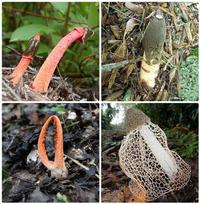 Clockwise from upper left: Tom Volk, Ted Geibel, Troy Bartlett, and Gloria Schoenholtz. From the University of Wisconsin-Madison Division of Extension
Clockwise from upper left: Tom Volk, Ted Geibel, Troy Bartlett, and Gloria Schoenholtz. From the University of Wisconsin-Madison Division of ExtensionMore information: Stinkhorn Mushroom
- January, February, March, October, November, December -
Mushrooms
- Sometimes it seems like there are mushrooms all over: mushrooms in the lawn; mushrooms on the trees; mushrooms in fertilizer; mushrooms in the woods; there is even mushroom compost available. How do you know which mushrooms are desirable and which are not? This can be a life or death determination, both for you and for your plants. Mushrooms are the fruiting bodies we see of fungi which can be widespread and hidden underground or inside plants. Fungi play a beneficial role in decomposition and in providing nutrients to garden plants. Mushrooms in the lawn can be a sign of overwatering, so check the irrigation and drainage. You don't need to remove the mushrooms except to protect young children and pets from eating them. If cultivating or harvesting mushrooms to eat, be sure that you know it is not a poisonous variety.
More information: Mushrooms in lawns- January, February, December
2. What to plant
-
California Natives
- Thinking of adding native California plants to your yard? New natives respond best to wet winter weather, which promotes the extensive root development needed for spring growth and the hot dry summer months ahead. Your next question may be what to plant. That depends on your planting site and the individual cultural requirements of the plant. To help, the California Native Plant Society has created a database where you can enter your address and find which plants do best in your neighborhood for the conditions in your yard, like sun or shade. The website even lists nurseries that carry California natives.
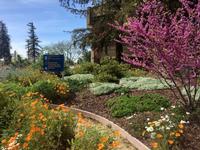 More Information:- January, February, March, December
More Information:- January, February, March, December -
Camellias
- Camellias can be planted in fall through spring. Since they bloom in winter, choosing a plant now will ensure that you know the color, shape, and size of the flowers with which you will live for many years. Camellias are not native to our area so may need some extra attention in order to grow successfully. Our native clay soil does not drain well so it must be amended for camellias. Our alkaline soil needs to be acidified, and sulfur pellets are one way to achieve this. The plants need some shade and need to be kept moist. Mulch helps hold in moisture, and pine needles, redwood bark, and coffee grounds are all good organic materials that will break down over time and help improve the soil. Pick up flowers as soon as they fall to the ground to avoid the spreading of a disease called Camellia petal blight.
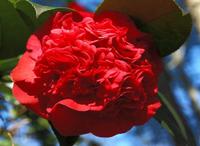
More information: Camellia Pests
- January, February, March, April, May, September, October, November, December -
Onions
- This is a good time to plant onions for nice big bulbs. Onions are biennial plants which means that they are programmed to go to seed in their second year. If they are planted too early in the year and grow too large before cold weather hits, they can be tricked in the spring into acting as if they are in their second year. This means that they will go to seed soon and put their energy into reproducing themselves rather than into growing large bulbs. Ideally, they should be no bigger than the thickness of a pencil when the cold weather causes them to go dormant. Plant onions from seeds if earlier in the fall or transplants if later. They do best in moist, well-drained soil. Harvest bulbs in the summer when the tops die back. You can plant green onions at any time and harvest them whenever they are about a quarter to half-inch in diameter.
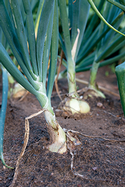 Onions, by Iowa State University
Onions, by Iowa State UniversityMore information: Growing onions
- November, December -
Poinsettias
- Poinsettias are tropical plants, so they'll do best in a warm, sunny place in your house. The soil can easily dry out and become hydrophobic, so make sure to check the soil moisture regularly. There’s really no need to fuss over them if you’re only keeping them for a few weeks of holiday color. If you want them to bloom again next year in time for the holidays, UC has Poinsettia Care Tips that describe what to do; just be aware that it is a little tricky.
Did you know that the red parts are actually bracts (modified leaves) and that the true flowers are the little yellow parts in the centers? You can also plant them outdoors with protection from frost. They have been seen growing as tall as eight feet in San Jose, and taller in their native Mexico.
- January, December -
Amaryllis or is it Hippeastrum?
- The showy red Amaryllis (more correctly called Hippeastrum) is a great bulb for growing indoors if you can’t wait for your outdoor bulbs to bloom in spring. Choose a pot just slightly larger than the bulb. Plant it in loose potting soil with a third of the bulb sticking up above the soil surface. Keep moist, but not so wet as to rot the bulb. The University of Minnesota Extension has information on general care and how to control blooming. - January, December
 Brighten the holidays with Amaryllis (Photo: UC Solano Master Gardeners)
Brighten the holidays with Amaryllis (Photo: UC Solano Master Gardeners)
3. Pests and Diseases
-
Mistletoe
- The dense mass of leafy balls high up in trees is broadleaf mistletoe. There are multiple species in California, both native and introduced. Mistletoe is a hemiparasite, meaning it can photosynthesize on its own, but draws nutrients and water from its host. Birds feast on the translucent white berries, spreading the sticky seeds to new locations. When a seed sprouts, it sends out a modified root that penetrates the tree’s bark. A healthy tree can support a moderate infestation, but if the infestation is heavy or if a tree is stressed by other factors such as disease or drought, it can kill the tree.
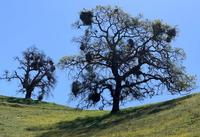 More information: Mistletoe Quick Tips- December
More information: Mistletoe Quick Tips- December -
Oak Root Fungus
-
This fungal infection, Armillaria Mellea, also known as mushroom root rot, honey fungus and shoestring fungus can cause foliage to become sparse and eventually kill the tree. The white or cream-colored fungus will grow between bark and wood of roots and up into the lower part of the tree trunk. It smells like your typical grocery store mushroom.
In spring or fall there may be mushrooms growing around the base of the infected tree. If the disease has not progressed too far, you can cut out infected tissue and expose the base of the tree and roots to air. Reduce watering especially close to trunk. No chemical treatment is known to be effective.
Plants Resistant or Susceptible to Armillaria mellea, The Oak Root Fungus by Robert D. Raabe contains more detailed information. The UC Master Gardener video Revealing Root Rot can help with detection of two common root pathogens and provide guidance on how to reduce the spread.
- December -
Peppertree Psyllids
-
This pest can cause damage to California pepper trees. The damage is done when the insect is in its immature stage. They make doughnut-like pits on leaves that wrinkle or twist the leaves as well. Parasitic wasps can provide satisfactory control. See the UC Pest Note on Psyllids for more information.
- December -
Snails and Slugs
- Escargot may sound good on a plate, which is where the French who brought this delicacy to California in the 1850s intended for the ingredients to stay, but they escaped into gardens where they became pests. Brown garden snails are the most common ones we see (or don’t see) eating our plants. Signs of their presence include holes in fruit rinds and leaves, not necessarily at the edges, and slime trails. They tend to hide in dark damp places during the day and come out mostly at night. The best times to find them are at night with a flashlight, early in the morning, or during and right after heavy rain. They can be hand-picked and crushed or put in a bucket of soapy water. Gloves are recommended, especially with the shell-less slugs. Creating hiding places, such as laying a wooden board over a section of the garden, will draw them to that location so you can find and dispatch them in the morning. Copper barriers and beer traps are other options. If you do use snail bait, those made with iron phosphate are not toxic to pets and wildlife.
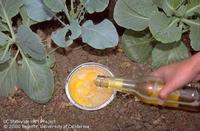
More information: Snails and Slugs
- January, February, March, April, December -
Sooty Mold
- If your citrus leaves have a black coating, you may have a sooty mold problem. This black mold can also be seen on citrus fruit, avocado leaves, magnolia leaves, hibiscus, other host plants, and even on sidewalks beneath trees.
The sooty mold fungi grow on “honeydew”, a sticky substance excreted by plant-sucking insects such as aphids, scale, mealybug, and whitefly. They suck the sap out of plants and excrete excess sugars. It exists purely on the surface of a plant and is not a systemic issue. By itself, the fungi cannot kill the plant but it can coat the leaves to the extent that sunlight is prevented from reaching the leaf surface, thus reduce photosynthesis.
Ants protect the sucking insects from their predators so they can eat the honeydew. Keep ants out of trees and away from honeydew-producing insects by applying a sticky compound such as Tanglefoot on a tape wrapped around the trunk.
Pruning branches to allow better air circulation also helps. You can hose off the mold itself with a strong jet of water. And you can eat the fruit once you wash off the sooty mold.- August, September, October, November, DecemberFor more information, see Sooty Mold Management Guide. -
Limes
- Limes are easy to grow in our area and make a pretty addition to the landscape. They don’t take up as much space as some other citrus and can grow well in our native soil with plenty of sun. They need some fertilizing and occasional protection from the cold. Bearss Lime is a popular variety that has fruit ripening now. Other favorites include Mexican Lime, Australian Finger Lime, and a Limequat hybrid. Most limes are yellow when fully ripe and have a higher juice content at this stage; most limes in stores are green because they have a longer post-harvest life or shelf life. A tan, leathery sunken area at the end of the fruit is called blossom end rot in citrus. It can come from insufficient water, preventing calcium from getting all the way to the ends of the fruit (similar to blossom end rot in tomatoes.) You can freeze the fruits whole for year-round margaritas or whatever it is you do with your limes. Freezing weakens the cell walls, which makes it even easier to juice the limes after thawing.
More Information: Growing Citrus Fruits
- January, November, December -
White Mold on Lettuce and Brussels Sprouts
-
White mold is a distinctive disease that most often affects stems and foliage at the base of cole crops* and lettuce plants. Affected tissue develops a soft, watery rot and white, cottony mycelium forms on the surface. Plants may wilt if stems are girdled by the decay. As affected tissue dries up, it turns yellow to white, and hard black sclerotia form on the surface or inside the dead stems. Get more information in the UC Pest Note on White Mold.
* Cole crops include broccoli, Brussels sprouts, cabbage, cauliflower, collards, kale, and kohlrabi
- November, December -
Don't Move Firewood
- Tree-killing insects and diseases can lurk in or on firewood. These insects and diseases can’t move far on their own, but when people move firewood, these pests can jump hundreds of miles. Beetles that have done significant damage in Southern California are the Goldspotted Oak Borer and Invasive Shot Hole Borers. Let’s keep them out of Santa Clara County.
 More Information: Don’t Move Firewood campaign- January, December
More Information: Don’t Move Firewood campaign- January, December -
Slime Molds
- Slime molds come in a variety of colors and shapes. They often appear suddenly and look worrisome. They are fungi and need moisture to grow. According to the Mississippi State Extension, “when slime molds find something to eat, they surround their food and then swallow it. Slime molds may feed indirectly on dissolved substances escaping from organic matter, but they usually feed on microorganisms such as bacteria.” In general, no action is needed. When the area dries out, the slime mold will disappear. Just enjoy this marvel of nature while it’s there.
- January, February, March, April, October, November, December -
Citrus Leafminer
- What causes young, healthy citrus leaves to become gnarled and disfigured and what can be done about it? This damage is due to the citrus leafminer moth that lays eggs on new citrus leaves. Its larvae burrow into the leaf and leave tunnels as they feed, visible as meandering serpentine mines. Our advice: don’t worry about it. Leafminers can slow the growth of young trees but even heavily damaged trees are unlikely to die. Leafminers only attack young leaves — the tough leaves of mature plants resist infestation and fruit is not affected. Damaged leaves still produce food for the tree, so don’t cut them off. If you do, it will stimulate the tree to produce more new leaves — which will attract more leafminers!
More information: Citrus Leafminer
- January, February, March, April, May, September, October, November, December -
Armillaria Root Rot
- Mushrooms at the base of a tree could signal a problem with the tree. Armillaria is a fungus that can live in the soil for many years. It can rot the roots and cause leaves and branches to die and can eventually kill a plant. Another common term is Oak Root Fungus, although it affects many different species of trees and even some herbaceous plants. Often by the time the fruiting bodies (mushrooms) are visible, much damage has already been done. It feeds on both live and decaying wood. Cutting back a small section of bark can reveal white fan-shaped or black stringy fungus which aids in diagnosis. Keeping the plant healthy provides some defense. Fungi thrive in moist conditions, so do not overwater the area. Also, keep mulch and other plants away from the trunks of trees so as not to hold moisture against the crown (base). The best defense against this disease is to plant resistant varieties.
For information: Armillaria Root Rot
- January, February, December








